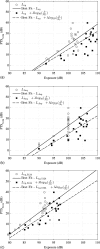Kurtosis corrected sound pressure level as a noise metric for risk assessment of occupational noises
- PMID: 21428511
- PMCID: PMC3188614
- DOI: 10.1121/1.3533691
Kurtosis corrected sound pressure level as a noise metric for risk assessment of occupational noises
Abstract
Current noise guidelines use an energy-based noise metric to predict the risk of hearing loss, and thus ignore the effect of temporal characteristics of the noise. The practice is widely considered to underestimate the risk of a complex noise environment, where impulsive noises are embedded in a steady-state noise. A basic form for noise metrics is designed by combining the equivalent sound pressure level (SPL) and a temporal correction term defined as a function of kurtosis of the noise. Several noise metrics are developed by varying this basic form and evaluated utilizing existing chinchilla noise exposure data. It is shown that the kurtosis correction term significantly improves the correlation of the noise metric with the measured hearing losses in chinchillas. The average SPL of the frequency components of the noise that define the hearing loss with a kurtosis correction term is identified as the best noise metric among tested. One of the investigated metrics, the kurtosis-corrected A-weighted SPL, is applied to a human exposure study data as a preview of applying the metrics to human guidelines. The possibility of applying the noise metrics to human guidelines is discussed.
© 2011 Acoustical Society of America
Figures


Similar articles
-
The value of a kurtosis metric in estimating the hazard to hearing of complex industrial noise exposures.J Acoust Soc Am. 2013 May;133(5):2856-66. doi: 10.1121/1.4799813. J Acoust Soc Am. 2013. PMID: 23654391 Free PMC article.
-
The effects of the amplitude distribution of equal energy exposures on noise-induced hearing loss: the kurtosis metric.J Acoust Soc Am. 2003 Jul;114(1):386-95. doi: 10.1121/1.1582446. J Acoust Soc Am. 2003. PMID: 12880050
-
The application of frequency and time domain kurtosis to the assessment of hazardous noise exposures.J Acoust Soc Am. 1994 Sep;96(3):1435-44. doi: 10.1121/1.410287. J Acoust Soc Am. 1994. PMID: 7963007
-
Noise dosimetry for tactical environments.Hear Res. 2017 Jun;349:42-54. doi: 10.1016/j.heares.2016.11.008. Epub 2016 Nov 20. Hear Res. 2017. PMID: 27876480 Review.
-
Impulsive noise: A brief review.Hear Res. 2017 Jun;349:34-36. doi: 10.1016/j.heares.2016.10.020. Epub 2016 Oct 27. Hear Res. 2017. PMID: 27989948 Review. No abstract available.
Cited by
-
Fatigue Modeling via Mammalian Auditory System for Prediction of Noise Induced Hearing Loss.Comput Math Methods Med. 2015;2015:753864. doi: 10.1155/2015/753864. Epub 2015 Nov 24. Comput Math Methods Med. 2015. PMID: 26691685 Free PMC article.
-
Application of the Kurtosis Metric to the Assessment of Hearing Loss Associated with Occupational Noise Exposure.China CDC Wkly. 2021 Apr 30;3(18):390-393. doi: 10.46234/ccdcw2021.105. China CDC Wkly. 2021. PMID: 34594890 Free PMC article. No abstract available.
-
Temporary threshold shift after impulse-noise during video game play: laboratory data.Int J Audiol. 2014 Mar;53 Suppl 2(0 2):S53-65. doi: 10.3109/14992027.2013.865844. Int J Audiol. 2014. PMID: 24564694 Free PMC article.
-
The association between subcortical and cortical fMRI and lifetime noise exposure in listeners with normal hearing thresholds.Neuroimage. 2020 Jan 1;204:116239. doi: 10.1016/j.neuroimage.2019.116239. Epub 2019 Oct 3. Neuroimage. 2020. PMID: 31586673 Free PMC article.
-
An overview of occupational noise-induced hearing loss among workers: epidemiology, pathogenesis, and preventive measures.Environ Health Prev Med. 2020 Oct 31;25(1):65. doi: 10.1186/s12199-020-00906-0. Environ Health Prev Med. 2020. PMID: 33129267 Free PMC article. Review.
References
-
- Atherley, G. R., and Martin, A. M. (1971). “Equivalent-continuous noise level as a measure of injury from impact and impulse noise,” Ann. Occup. Hyg. 14, 11–23. - PubMed
Publication types
MeSH terms
Grants and funding
LinkOut - more resources
Full Text Sources
Other Literature Sources
Medical

